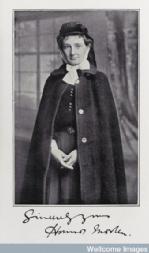Seminar 14: Call the Midwife
 |
The nineteenth and twentieth centuries have seen rapid and far-going changes in the delivery of maternity care, a shift from home to hospital as the usual place of birth, the ‘take over’ of the direction of childbirth by male practitioners and a vast increase in obstetric technology, including pain relief. This week we will explore these major shifts and the ways in which they have impacted on the lives of mothers and fathers, families and those who provide midwifery care, as well as changing expectations of childbirth and its management. We will also explore the ways in which oral history and autobiography has shaped the telling of the midwife’s tale. |
Seminar Reading:
L. McCray Beier, ‘Expertise and Control: Childbearing in Three Twentieth-Century Working-Class Lancashire Communities’, Bulletin of the History of Medicine, 78 (2004), 379-410. e-journal
L.V. Marks, ‘‘They’re Magicians’: Midwives, Doctors and Hospitals. Women’s Experiences of Childbirth in East London and Woolwich in the Inter-war Years’, Oral History, 23 (1995), 46-53. e-journal
L. King, 'Hiding in the Pub to Cutting the Cord? Men’s Presence at Childbirth in Britain c.1940s–2000s', Social History of Medicine, 30:2 (2017), 389-407. e-journal
Primary Sources
Jennifer Worth, Call the Midwife (Twickenham: Merton, 2002). (the book is available on Amazon for c. £4 new and £1 plus P&P 2nd hand). Also check out your local charity shop. There is also always the option of watching a few episodes on the BBC too!)
Nicky Leap and Billie Hunter, The Midwife’s Tale: An Oral History from Handywoman to Professional Midwife (London: Scarlet Press, 1993).
Ann Oakley, From Here to Maternity: Becoming a Mother (Harmondsworth: Penguin, 1981) for scanned extract click here
Additional Reading:
Angela Davis, ‘A Revolution in Maternity Care? Women and the Maternity Services, Oxfordshire c.1948-1974’, Social History of Medicine, 24 (2011), 389-406. e-journal
Angela Davis, Modern Motherhood: Women and Family in England, 1945-2000 (Manchester and New York, Manchester University Press, 2012), ch. 4. e-book
Lucinda McCray Beier, For Their Own Good: The Transformation of English Working Class Culture, 1880-1970 (Columbus, OH: Ohio State University Press, 2008), ch. 6.
Jean Donnison, ‘Medical Women and Lady Midwives: A Case Study in Medical and Feminist Politics’, Women’s Studies, 1976 (3), 229-50. e-journal
Jean Donnison, Midwives and Medical Men (New Barnett: Historical Perspectives, 1988).
C. Gowdridge, S.A. Williams and M. Wynn (eds), Mother Courage: Letters from Mothers in Poverty at the End of the Century (Harmondsworth: Penguin in Association with The Maternity Alliance, 1997).
Joan Lane, A Social History of Medicine (London: Routledge, 2001), ch. 7.
J.S. Lewis, In the Family Way: Childbearing in the British Aristocracy 1760-1860 (New Brunswick, NJ: Rutgers University press, 1986).
Margaret Llewelyn Davies, Maternity: Letters from Working Women (1st published 1915, Virago edn 1978).
Irvine Loudon, ‘Maternal Mortality: 1880–1950. Some Regional and International Comparisons’, Social History of Medicine, 1 (1988), 183-228. e-journal
Irvine Loudon, ‘On Maternal and Infant Mortality 1900–1960’, Social History of Medicine, (1991) 4 (1991), 29-73. e-journal
Irvine Loudon, Death in Childbirth: An International Study of Maternal Care and Maternal Mortality 1800-1950 (Oxford: Clarendon Press, 1992).
Lara V. Marks, Model Mothers: Jewish Mothers and Maternity Provision in East London 1870-1939 (Oxford: Oxford University Press, 1994).
Hilary Marland, ‘Childbirth and Maternity’, in Roger Cooter and John Pickstone (eds), Medicine in the Twentieth Century (Amsterdam, etc: Harwood, 2000), 559-74.
Hilary Marland and Anne Marie Rafferty (eds), Midwives, Society and Childbirth: Debates and Controversies in the Modern Period (London and New York: Routledge, 1997).
Tania McIntosh, ‘Profession, Skill or Domestic Duty: Midwifery in Sheffield 1881-1936’, Social History of Medicine, 11 (1998), 403-20. e-journal
Tania McIntosh, ‘“An Abortionist City”: Maternal Mortality, Abortion and Birth Control in Sheffield, 1920-1940’, Medical History, 44 (2000), 75-96. e-journal
Alison Nuttall, ‘Passive Trust or Active Application: Changes in the Management of Difficult Childbirth and the Edinburgh Royal Maternity Hospital, 1850-1890’, Medical History, 50 (2006), 351-72. e-journal
A. Oakley, The Captured Womb: A History of the Medical Care of Pregnant Women (Oxford: Basil Blackwell, 1984).
E. Ross, Love and Toil: Motherhood in Outcast London, 1870-1918 (New York: Oxford University Press, 1993), ch. 7.
M. Tew, Safer Childbirth: A Critical History of Maternity Care (London: Chapman and Hall, 1995).
Mary Thomas (ed.), Post-war Mothers. Childbirth Letters to Grantly Dick-Read, 1946-1956 (Rochester, NY: University of Rochester Press, 1997).
J. Towler and J. Bramall, Midwives in History and Society (London: Croom Helm, 1986).
A. Susan Williams, Women and Childbirth in the Twentieth Century (Stroud: Sutton Publishing, 1997).
Robert Woods, ‘Laying-in and Laying-out: Fetal Health and the Contribution of Midwifery’, Bulletin of the History of Medicine, 81 (2007), 730-59. e-journal
Essay Questions
How have expectations of women and their families changed with regard to childbirth in the twentieth centuries?
How and why have men's roles in childbirth changed?
To what extent was birth medicalised in the twentieth century?
Drawing on the testimonials of mothers and midwives, examine whether the medicalisation of childbirth has led to 'improvements' in women's experiences.
